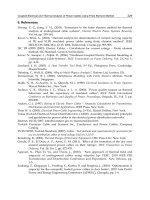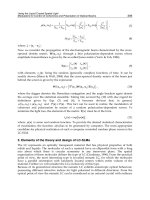Biomedical Engineering From Theory to Applications Part 9 docx
Bạn đang xem bản rút gọn của tài liệu. Xem và tải ngay bản đầy đủ của tài liệu tại đây (5.12 MB, 30 trang )
Biomedical Engineering – From Theory to Applications
230
Polymer-coated CdSe/ZnS core shell quantum dots were first conjugated to diamino-
modified PEG molecules and then to GSH through amide bond formation. The resulting
bioconjugated were extensively characterized to confirm the presence of the surface
functionalizations (Tortiglione et al., 2007).
Both PEG-QDs and PEG-GSH-QDs were supplied to living polyps at different
concentrations and then observed by fluorescence microscopy. A biological response
consisting in mouth opening and QD entry into the gastric cavity was elicited by GSH-QDs.
The elicitation of this behaviour, although slightly different from the classical feeding
response (consisting of tentacle writhing and mouth opening) and occurring in a small
percentage of animals (15%), was specific for GSH coated QDs, and indicated the bioactivity
of the new GSH abduct. Fluorescent QD targeted cells were found within the inner
endodermal cells, which internalized the QD upon mouth opening (see Figure 4)
(Tortiglione et al., 2007).
Fig. 4. In vivo fluorescence imaging of Hydra polyps treated with 300 nM GSH-QDs
(emission max: 610 nm).
a) Bright field image of Hydra treated with GSH-QDs showing animal basic structure. The
foot is on the lower part of the panel, while a crown of tentacles surrounds the mouth. b)
Image taken 24 h after treatment: an intense fluorescence is distributed all along the gastric
region. c) Cellular localization of QDs in Hydra cross sections. The whole Hydra was treated
with 300 nM GSH-QDs for 24 h, fixed in 4% paraformaldehyde, and included for
cryosectioning. Images were collected using an inverted microscope (Axiovert, 100, Zeiss)
equipped with fluorescence filter sets (BP450-490/FT510/LP515). Endodermal cells(en) are
separated from ectodermal cells (ec) by an extracellular matrix, the mesoglea (m), indicated
by the arrow. Red fluorescence corresponds to GSH-QDs located specifically into
endodermal cells. Scale bars: 500
m in a, b; 200
m in c
The fluorescence pattern and intensity lasted unaltered until the animals were fed again,
after which the signal started to fade slowly and was diluted throughout the emerging buds
(Figure 5).
An Ancient Model Organism to Test In Vivo Novel Functional Nanocrystals
231
Fig. 5. Tracking QD fluorescence under normal feeding regime
Biomedical Engineering – From Theory to Applications
232
GSH-QDs do not undergo degradation into the endodermal cells. They follow cell turnover
and migration towards the animal ends and the developing bud. Hydra treated with GSH-
QDs were fed on alternate days. After three feeding cycles GSH-QDs were found diluted
among the endodermal cells, continuously diving. The orange fluorescent punctuated
pattern decreases uniformly as new buds are formed on the mother (see lower panel,
representing an adult with an emerging bud). Scale bars are 200 m in all pictures.
The uptake of GSH-QDs was an active endocytotic process, as shown by its inhibition when
performing the incubation at 4 °C. Tissue cryosection and dissociation of whole treated polyps
into single cell suspensions confirmed the presence of QDs into cytoplasmic granular vesicles.
In conclusion this first work showed that GSH-QDs alone can stimulate a response, although
in a small percentage (15%) of the treated animals. Possible reasons for this low percentage
could be a low concentration of the GSH molecules conjugated to the QD surface or the
modified stereochemical conformation of the bound GSH molecules, which does not allow for
correct interaction with the protein target. Although the bioactive GSH-QDs could target
specific cells, as shown by the fluorescence of the endodermal layer, the nature of the GSH
binding protein (as GSH receptor, GSH transporters ) remain to be determined. An important
clue emerged from this study was the capability of PEG-QDs to be also internalized by
endodermal cells, upong chemical induction of mouth opening. The uptake rate was lower
compared to GSH-QDs, indicating different internalization routes and underlying mechanism
for the two types of QDs. Considering the multiple roles played by glutathione in metabolic
functions, and in particular in the nervous system of higher vertebrates, GSH functionalized
nanocrystals prepared and tested in this work represent promising tools for a wide variety of
investigations, such as the elucidation of the role played by GSH in neurotransmission and the
identification of its putative receptor. Beside these considerations, the capability of PEG-QDs
to be up taken by Hydra cells prompted us to investigate more in detail the mechanism of
internalization of QDs, the role played by the surface ligand, the surface chemistry and charge,
which underlies any bio-non –bio interaction.
3.2 Unfunctionalized Quantum Rods elicit a behavioural response in Hydra vulgaris
The capability of Hydra to internalize, upon chemical induction of mouth opening, PEG-QDs
into endodermal cells suggested that also unfunctionalized nanocrystals can play active
roles when interacting with living cells. Noteworthy attention should be paid to the
chemical composition of surfactant-polymer-coated nanoparticles not only in determining
their stability in aqueous media but also in investigating their interaction with cells and
intracellular localization. With the aim to test the impact of a new kind of semiconductor
nanocrystal on Hydra vulgaris, we demonstrated that specific behaviours might be induced
by exposure of whole animals to unfunctionalized nanocrystals and that a careful
investigation of the impact of the new material on living cells must be carried out before
designing any nanodevice for biomedical purposes (Malvindi et al., 2008).
The nanocrystals under investigation were fluorescent CdSe/CdS quantum rods (from here
named QRs). In addition to QD properties, such as bright photoluminescence (PL), narrow
emission spectra, and broad UV excitation, QRs have larger absorption cross-sections, which
might allow improvement to certain biological applications where extremely high
brightness and photostability are required. QRs of length and diameter 35 2 nm and 4.2
0.4 nm, respectively, were synthesised according to a newly developed procedure (Carbone
et al., 2007), and transferred to aqueous medium by using the same met
hodology described
above for QDs (Pellegrino, 2004; Sperling, 2006; Williams, 1981). The resulting highly
An Ancient Model Organism to Test In Vivo Novel Functional Nanocrystals
233
fluorescent PEG coated QRs (Figure 6) were challenged to living polyps, which were
monitored over progressive incubation periods.
Fig. 6. A schematic representation of the CdSe/CdS rods used in this study
The scheme shows the asymmetrical shape derived from the synthesis procedure (Carbone
et al, 2007). The method involves coinjecting Cd
2+
and S
2-
precursors and preformed
spherical CdSe seeds into an environment of hot surfactants, well suited for the anisotropic
growth of the second shell-material (CdS) on the first underlying core (CdSe). Resulting QRs
are transferred from chloroform to water by wrapping them within an amphiphilic polymer
shell (blue shell in the figure). To these polymer-coated QRs, polyethylene glycol (PEG)
molecules (red shell) can be bound by using an EDC catalyzed cross linking scheme. The
rod samples are an average of 35nm in length and 4 nm in diameter as confirmed by b) the
TEM image of the corresponding sample (generously provided by Dr.A.Quarta, Italian
Institute of Technology, Lecce, Italy)
Unlabelled cells were detectable by fluorescence microscopy, indicating that QRs were not
uptaken by Hydra ectodermal cells. However, an unexpected animal behaviour was
observed which consisted of an intense tentacle writhing, i.e. contractions and bending
along the axial length of each tentacle, as shown in Figure 7.
Fig. 7. Elicitation of tentacle writhing by QRs.
The test was initiated by adding CdSe/CdS core/shell QRs to each well containing six
polyps and motor activity was monitored by continuous video recording using a Camedia-
digital camera (Olympus) connected to a cold light Wild stereo microscope a) Hydra polyp
Biomedical Engineering – From Theory to Applications
234
in physiological condition show extended tentacles. b) Within seconds of addition of QRs to
the culture medium the polyp’s tentacle begin to writhe, bending toward the mouth.
Contractions are not synchronous for all tentacles and lasted for an average of ten minutes
(Malvindi et al., 2008).
The elicitation of this behaviour over an average period of ten minutes was dependent on
the presence of calcium ions into Hydra medium, as shown by the inhibition of such activity
by the calcium chelator EGTA. Interestingly, Hydra chemically depleted of neuronal cells
were unresponsive to QRs, indicating that excitable cells are targeted by QRs. The
mechanisms underlying neuron excitation are still under investigation, but the shape
anisotropy has been shown involved in the elicitation of the activity, as nanocrystals of the
identical chemical composition, but shaped as dots were ineffective. We suggested that
CdSe/CdS QRs, regardless of surface chemical functionalization, may generate local electric
fields associated with their permanent dipole moments that are intense enough to stimulate
voltage dependent ion channels, thus eliciting an action potential resulting in motor activity.
Results from a geometrical approximation (Malvindi et al., 2008) showed that a QR voltage
potential of sufficient intensity to stimulate a voltage gated ion channel can be produced at
nanometric separation distances, i.e. those lying between cell membranes and medium
suspended QR, regardless of its orientation at the cell surface, thus it is theoretically possible
for QRs to elicit neuronal activity. This hypothesis is currently under investigation in
vertebrate model systems. In particular, we have preliminary data on the modulation of the
electrophysiological properties of mammalian brain slices by QRs, (unpublished data)
which indicate that QR response is not specific to our experimental model. Considering the
challenges encountered in the design and synthesis of electrical nanodevices for neuronal
stimulation (Pappas, 2007) we propose biocompatible, soluble QRs as a novel resource for
neuronal devices, for diagnostic and therapeutic applications where non invasive probing
and fine tuning of neuronal activity is required.
The peculiarities of our biological model system, such as the low-ionic-strength culture
media and the presence of excitable cells directly facing the outer media, allowed us to
highlight the neuronal stimulation by a nanometric inorganic particle, which might be
difficult to study in vivo in a more complex whole organism. Avoiding the difficulties in
investigating vertebrate brain behaviour in vivo, our cnidarian model organisms provided a
simple, reliable, and fast system for screening nanoparticle activity in vivo on a functionally
connected nerve net.
3.3 Unfunctionalized Quantum Rods reveals regulated portal of entry into Hydra cells
The complexity of the molecular interactions underlying the endocytosis suggests that a
great evolutionary effort has been spent to regulate the cellular response to a variety of
different environmental stimuli. In multicellular organisms the endocytic and secretory
pathways evolved to control all aspects of cell physiology and intercellular communication
(neurotransmission, immune response, development, hormone-mediated signal
transduction). In this scenario, the emerging nanomaterials, variable in size (from 2 to 100
nm), chemical composition (gold, cadmium telluride, cadmium selenide, iron oxide) and
physical properties (charge, spectral profile, colloidal stability, magnetism) represent a new
class of compounds interacting with biological systems, which underlying mechanisms need
to be carefully investigated. When studying the impact of CdSe/CdS QRs on Hydra
(Malvindi et al., 2008), beside the detection of a specific behavioural response, an accurate
microscopy analysis was performed in order to assess the putative internalization of the
An Ancient Model Organism to Test In Vivo Novel Functional Nanocrystals
235
QRs into Hydra cells. At neutral pH, QR uptake was never detectable at the concentrations
(7nM) eliciting biological activity. By contrast, using the same concentration of CdSe/CdS
QRs, but changing the pH of the Hydra medium toward mild acidic values (pH 4.5- 4), an
intense fluorescence was observed (Tortiglione et al., 2009). The labelling pattern as soon as
30 minutes post incubation with QRs appeared like a uniform red fluorescence staining all
around the animal (Figure 8a). In the following hours membrane bound nanocrystals
appeared compacted within cytoplasmic granular structures, easily detectable as red spots
at level of the tentacles first (Figure 8b), and then throughout the body (Figure 8c).
Fig. 8. In vivo fluorescence imaging of Hydra vulgaris exposed to QRs for different periods
a) In vivo image of two Hydra, 30 minutes post incubation (p.i.): QR red fluorescence labels
uniformly all body regions. A second Hydra is placed horizontally below b) In vivo image of
a polyp 2h p.i. with QRs. A strong punctuated fluorescence labels the mouth, the tentacles
and at a lower extent the animal body. c) Later on, in most of the animals, the punctuated
fluorescence is evident also in body column.
Tissue cryosections made from treated animals allowed to detect not only the ectodermal
localization of the internalized QRs, but also the dynamic of the labelled cells, at various
time after incubation (Figure 9).
Fig. 9. Tissue localization of QRs in Hydra tissue sections.
Biomedical Engineering – From Theory to Applications
236
Intact Hydra were treated with QRs at acidic pH for 4 h, and 24 h later fixed and processed
for cryosectioning. The green colour is due to tissue autofluorescence, while the red staining
indicate the QR presence. Serial longitudinal tissue cryosections obtained at level of the
head ( a, b and c ) and body (d) show QRs located into the ectodermal cells, but also inside
endodermal cells lining both the tentacles and gastric region. A transversal section (e)
confirms the tissue distribution. The labelling pattern before sectioning is shown in (f). Scale
bars: 200 m (a-e), and 500 m (f).
Remarkably, 24 h post treatment, fluorescent material appeared also into the endodermal
cells lining the gastric cavity and the tentacles. At the tentacle base, the fluorescence draws a
well defined strip along the tentacle length, shown by cross sections to be localised inside
the endodermal cells and not in the tentacle lumen (Figure 9a, 9b, 9c). This cell dynamic,
from ectoderm to endoderm, has never been described using conventional organic
fluorophores and highlights the importance of using the innovative fluorophore to probe
biological processes. The high photostability of the QRs allowed to study with
unprecedented brightness and resolution endocytotic processes in Hydra and to track these
phenomena over long periods. The same dynamic was observed also during regeneration of
treated animals and it probably depends from autophagocytosis process occurring during
head regeneration (Tortiglione et al., 2009). Beside these results, we determined the factors
involved in the capability of Hydra to uptake QRs at acidic but not neutral pH and
investigated the roles played by the nanocrystal surface at one side and by Hydra
membranes at the other. QRs used in this study where stabilised by the addition of amino-
PEG coating. Zeta potential measurement showed that at acidic pH QRs were positively
charged, while at neutral pH their surface net charge was neutral or negative. Modifying the
amounts of amino-PEG molecules present on QR surface we were able to tune the QR net
charge and thus the up taking process. At acidic pH, the protonation of the PEG amino
terminal groups (NH
3+
) contributes to increase the positive charges while the protonation of
the carboxyl groups of the amphiphilic polymer shell causes a reduction of the negative
charges (COO
2-
) at the nanoparticle surface and indeed the sum of the two effects results in
a net positive surface of the QR (Figure 10). The different amounts of PEG molecules
attached at the same QR surface account for the different behaviours displayed by diverse
nanorod samples, independently from their size and shape. QRs presenting positive zeta
potential bind to negatively charged membrane lipids, and stimulate endocytosis processes.
A scheme of the QR protonation occurring at acidic pH is shown in Figure 10.
Fig. 10. Protonation/de-protonation state of the QRs.
An Ancient Model Organism to Test In Vivo Novel Functional Nanocrystals
237
A schematic view of the functional groups at the nanoparticle surface responsible for the
switching of the surface charge. At basic pH, the carboxy groups are negatively charged and
the amino groups are not protonated. At acidic pH, the carboxy and the amino groups are
both protonated, which account for a positive zeta potential value measured. At neutral pH,
the zeta potential measured in all cases is negative. The blue colour indicates the CdS/CdS
core, while the amphiphilic polymer and PEG coatings are pink coloured. Modified from
(Tortiglione et al., 2009).
We also investigated the biological factors involved in the internalization of QRs at acidic
pH, and found the involvement of a peculiar protein displaying a pH dependent behaviour,
named Annexin (ANX) (Moss and Morgan, 2004). ANXB12 is a Hydra protein belonging to
the annexins superfamily, able to insert into lipidic membranes and to form ion channels at
acidic but not neutral pH (Schlaepfer et al., 1992a; Schlaepfer et al., 1992b). As Hydra
treatment with anti-ANX antibody prevented QR uptake, we suggest that ANX mediates
the interaction with positively charged QRs, organizing membrane domains and uptake
processes, probably throughout the specie-specific amino terminal domain. In presence of
anti-ANX antibody, the endocytosis machinery is blocked, likely due to impairment of
functional or structural important ANX extracellular domains.
In conclusion, the combined effect of nanorod positive surface charge and structural
properties of cell membranes, at acidic pH, resulted in the active internalization of the
fluorescent nanoparticles into specific cell types and according to a precise temporal
dynamic. The availability of beautifully illuminated animals led to track fluorescent cells
during developmental and regeneration processes, and to describe, beside known migration
events, new cell dynamics and inter-epithelial/intercellular trafficking phenomena, which
intriguing meaning lays the foundations for further investigations. Thus, we provide an
example of how, probing cell and animal biology with nanosized compounds, we can
uncover novel biological phenomena, aware of our capability of finely tuning and
controlling this interaction for specific purposes.
The two examples of Hydra/QR interaction described in the two sections above show two
biologically relevant responses induced by the same nanocrystal, determined in one case by
the QR intrinsic shape dependent electrical properties, and in the other one by the QR
positive surface charge. These studies show that presentation of chemical information at the
same size scale as that of cell surface receptors may interfere with cellular processes,
eliciting unexpected responses, such as the activation of a behavioural responses, or cell
uptake, and that a simple experimental change, such as the pH of the medium used in the
bioassay, may determinate dramatic difference in the evoked response. Thus, the
interactions occurring at the interface bio-non bio are complex and depending on both
players, which need to be fully characterized when designing nanodevices targeting
biological systems.
3.4 Cadmium telluride QDs induce cytotoxic effects in Hydra vulgaris
The freedom to design and modify NCs to accomplish very specific tasks is currently
being realized. However, their unique properties, not present in conventional bulk
materials, such as enhanced magnetic, electrical and optical properties, have potential
implications in NC toxicity, such as elemental composition, charge, shape, surface area
and surface chemistry/derivatization. Several data of the inherent toxicity of some NCs
are available and indicate that they can affect biological behaviour at the organ, tissue
and cellular levels, and activate changes in the expression of stress-related or apoptotic
Biomedical Engineering – From Theory to Applications
238
genes (Choi et al., 2008; Rivera Gil et al., 2010). The great amount of data collected up
to today regards different materials, biological systems, and are strictly dependent on the
cell lines tested (Lewinski et al., 2008). This may be a result of interference with
the chemical probes, differences in the innate response of particular cell types, as well
as depending upon the different protocols used by different laboratories for the
nanoparticle synthesis and characterization, giving rise to not identical nanomaterials.
Therefore, for a single nanocrystal, the biological activities of NCs should be assessed by
multiple cell-based assays and should more realistically rely on animal models (Fischer
and Chan, 2007).
A primary source of QD toxicity results from cadmium residing in the QD core. Toxicity of
uncoated core CdSe or CdTe-QD has been discussed in several reports and is associated, in
part, with free cadmium present in the particle suspensions or released from the particle
core intracellularly (Derfus, 2004; Kirchner et al., 2005; Lovric et al., 2005a). Free radical
formation induced by the highly reactive QD core might also play crucial roles in the
cellular toxicity. Encapsulation of the CdSe-QD with a ZnS shell or other capping materials
has been shown to reduce toxicity, although much work remains to be completed in this
field. However, to accurately assess safety of shell or capped particles, the degradation of
the shell or capping material, along with its cytotoxicity must also be considered since
several groups have found increased toxicity associated to capping materials such as
mercaptoacetic acid and Topo-tri-n-octylphosphine oxide (TOPO) (Smith et al., 2008). Taken
together, these reports suggest that the integrity of shell and capping materials, as well as
toxicity, needs to also be more thoroughly assessed and that shell/capping materials must
be assessed for different QD preparations.
Based on these considerations long term studies of effects on both cell viability and signal
transduction are needed, and surely the animal studies are definitely required for proper
assessment of QD toxicity. To date, rats have been used as model organisms for
pharmacological studies, and only recently the use of invertebrates to test Cd based QDs is
adding valuable informations in this field. For example, the freshwater macroinvertebrate,
Daphnia magna, has been used to evaluate toxicity characteristics of CdSe/ZnSe in relation
to surface coatings (Lee, 2009).
Cnidaria are sensitive to many environmental stressors and may become valuable indicators
of exposure to disruptive chemicals and other stressors, such as nanomaterials. During
animal evolution, an array of gene families and pathways (also known as “environmental
genes”) have evolved to face physical, chemical, and biological stressors. While the immune
system responds to biotic stressors such as pathogens (Miller et al., 2007), another set of
genes named “chemical defensome” (Goldstone, 2008), has been identified to sense,
transform, and eliminate potentially toxic chemicals.
Hydra is sensitive to a range of pollutants and has been used to tests on water
contamination by heavy metals (Holdway et al., 2001; Pascoe et al., 2003; Pollino and
Holdway, 1999). Metal pollutants such as copper, cadmium and zinc have been tested
against different Hydra species, and the relative toxicity based on the median lethal
concentration (LC50) for all species was ranked from copper, the most toxic, to cadmium,
with zinc least toxic (Karntanut and Pascoe, 2002; Karntanut and Pascoe, 2005). Drugs and
pharmaceuticals targeted at mammalian receptors have also been shown to adversely
affects Hydra (Pascoe et al., 2002), showing the feasibility to use this aquatic invertebrate
to accurately assess the potential toxicological effect of any kind of molecule added to the
animal culture medium.
An Ancient Model Organism to Test In Vivo Novel Functional Nanocrystals
239
In light of this knowledge we evaluated the possibility to use Hydra for nanotoxicology
purposes. We addressed the toxicological effects of fluorescent CdTe QDs, presenting
different chemical coatings on Hydra using several bioassays: 1) alteration of
morphological traits, measurable as morphological median score values 2) alteration of
reproductive capabilities, measurable as population growth rates 3) alteration of
regeneration or pattern formation. These three phenomena are schematically drawn in
Figure 11.
Fig. 11. Different developmental potentials available in the adult polyp.
The toxic effects of organic and inorganic pollutants, i.e, CdTe QDs, can be measured
using Hydra, due to its unique developmental potentials. The toxicant under investigation
can be added to the medium bathing living polyps and the effects on morphology,
reproductive and regeneration capabilities can be quantified by standardised protocols.
Upper panel: alteration of morphological traits can be measured by assigning numerical
scores to progressive morphological changes (Wilby, 1988)(see below). Middle panel:
upon regular feeding, the animals undergo asexual reproduction through budding: the
number of buds produced by a single polyp over two weeks can be expressed as
reproductive rate, which is altered in presence of toxicants. Lower panel: initially reported
by A.Trembley (Trembley, 1744), Hydra polyps can regenerate any missing part after
bisection of the body column performed at any level, and the presence of toxicants can
irreversibly affect this capability.
CdTe nanocrystals are the most successful example of the colloidal quantum dots directly
synthesized in aqueous solution. In Figure 12 a schematic representation of the synthesis of
TGA-capped QDs is shown. The methodology was first described by Gao (Gao M, 1998) and
it is routinely employed in many laboratories, although modifications have been further
developed to increase photoluminescence, quantum yields, or for specific applications in
Biomedical Engineering – From Theory to Applications
240
various fields ranging from light harvesting and energy transfer to biotechnology (Gaponik
and Rogach, 2010). The water-soluble CdTe QDs we analysed using Hydra were surface-
capped with thioglycolic acid (TGA) or stabilized by glutathione (GSH), synthesized as
described (Rogach and Lesnyak, 2007) and present a mean diameter of 3.1nm and 3.6nm,
respectively .
In our previous studies using CdSe/ZnS QDs or CdSe/CdS QRs evident toxicity signs
were not detected, even at the highest QD dose tested (300nM) (Tortiglione et al., 2007). In
those cases, nanocrystal synthesis was accomplished by burying a CdSe inner core into a
ZnS or CdS shell, then wrapping the metal core/shell by an amphiphilic polymer, further
stabilised by conjugation to PEG molecules. The CdTe QDs are sized only a few
nanometres and differ not only in chemical composition, but also in the synthetic route
(directly in aqueous solution) employing different compounds (thioglycolic acid or
glutathione ) as stabilising molecules. These differences drove our comparative toxicity
studies using CdTe QDs and testing different concentrations and exposure times (Tino et
al., 2011).
Fig. 12. Schematic representation of TGA capped QDs
The basics of the aqueous synthesis of thiol-capped CdTe NCs. In a typical standard
synthesis, Cd(ClO
4
) salts are dissolved in water, and an appropriate amount of the thiol
stabilizer is added under stirring, followed by adjusting the pH by dropwise addition of
NaOH. Under stirring, H
2
Te gas is then passed through the solution together with a slow
nitrogen flow. CdTe NC precursors are formed at this stage; formation and growth of NCs
proceed upon refluxing at 100°C under open-air conditions with a condenser attached (from
(Rogach and Lesnyak, 2007).
When challenging living polyps to CdTe QDs, adverse effects on animal behaviour and
morphology were immediately observed. In Figure 13 the pictures of polyps carrying
progressive damages are shown. These different damages have been annotated using a
An Ancient Model Organism to Test In Vivo Novel Functional Nanocrystals
241
scoring system ranging from 10 (healthy polyps) to zero (disintegrated animals) (Wilby,
1990), and already used for toxicological studies in Hydra. This system can be efficiently
adopted to compare toxicity of diverse compounds or the sensitivity of different species to a
given substance.
Fig. 13. Score system to assess toxic effects on Hydra
Examples of morphological alterations induced by treatment of living Hydra with CdTe
QDs. Animals were incubated with TGA-QDs and observed by a stereomicroscope over a
period of 72h. Images show progressive morphological changes scored from 10 down to 0,
according to the scoring system previously developed (Wilby, 1988)
By fluorescence microscopy we observed intense staining in animals treated with the
highest tested QD concentration (300nM), indicating QD uptake (Figure 14). At lower
concentrations, the low fluorescent staining did not allow imaging.
Elemental analysis by Inductively Coupled Plasma Atomic Emission Spectrometer (ICP-
AES) confirmed the internalization of the CdTeQDs (Ambrosone et al, unpublished).
Biomedical Engineering – From Theory to Applications
242
Fig. 14. In vivo fluorescence image of Hydra treated with 300nM TGA-QDs
Polyps were challenged with CdTe QDs and imaged after 2 hours of incubation. The polyp
appears contracted, the tentacles clubbed, shortened. The fluorescence is uniform all along
the animal (body and tentacles), drawing straight lines perpendicular to the main oral-
aboral axis, and corresponding to membranes belonging to adjacent cells aligned during
contraction. Granular structures are also present, indicating the initial uptake of QDs by
ectodermal cells.
We performed acute toxicity tests (by exposing the animals for two hours to QDs and then
monitoring the morphological scores), and chronic toxicity tests performing continuous
incubation with the QDs (Ambrosone et al, unpublished). Under both acute and chronic
treatment the median score values decreased with progressive exposure time, indicating
toxic effect (see Figure 15A). After 72 hr of continuous incubation with 25nM QDs, all
animals showed score value equal to zero, meaning that were all fully disintegrated. In
Figure 15B, the distribution of the different scores among the treated animals is shown at
each time point. Untreated animals showed always score 10 (blue bar, highlighted by the
upper red arrow), while treatment with QDs causes a decrease in the score values, more
pronounced for the higher QD concentration tested (25nM). In this latter case after 72 hr of
continuous incubation all animals were fully disintegrated, as highlighted by the red arrows
of Figure 15B.
The toxicity of CdTe QD to Hydra was further evaluated using a different method, based on
mortality. The number of death animals was used for survival statistical analysis, and the
Karber-Spearmann (Hamilton, 1977) method used to determinate the median lethal
concentration and the median lethal scores, as shown in Figure 15C.
An Ancient Model Organism to Test In Vivo Novel Functional Nanocrystals
243
Fig. 15. Methods used to evaluate the toxicity of CdTe-QDs on Hydra
Two different methods can be used to assess the toxicity of a given compound on Hydra. The
first method (used in A and B) is based on the evaluation of animal morphological traits,
while the second one (C) is based on survival rates. In A the time response toxicity curves to
equivalent TGA-QD concentrations are compared to the curves obtained by two different
concentrations of Cd salts. 25 Hydra were treated with the indicated compound and
morphological scores were monitored over 24, 48 and 72hr. In B the number of the animals
presenting different scores are reported for each time point in the three graphs (24, 48, 72hr).
The red arrows highlights that the score values decreasing from ten (untreated animals) to
zero obtained with 25nM concentration, after 72hr of incubation. In C the median lethal time
and median lethal concentration were calculated using the Sperman-Karber method.
In this way sub-lethal doses were determined and used for assessing the potential long-
term toxic effects induced by CdTe QDs on Hydra reproductive capabilities (Ambrosone et
al., 2011; Tino et al., 2011). Growth rate of Hydra tissue is regulated by the epithelial cell
cycle, which normal length (about 3 days) is controlled by environmental conditions, i.e.,
the feeding regime (Bosch and David, 1984). Thus, for a given feeding condition, the
growth rate is an indirect measure of the Hydra tissue growth and cell viability. The
number of individuals generated by an adult polyps over two-three weeks can be used to
calculate the growth rates constant (k), which is the slope of the regression line using the
standard equation of logarithmic growth: ln (n/n°) = kt (where n is the number of
individuals at the time t, and n° is the number of the founder polyps). Representative
growth rate curves determined for QD treated and untreated animals are shown in the
graph of Figure 15, and indicate k values lower for QD treated animals compared to
control. These differences were found significant by statistical analysis of repeated
experiments (Ambrosone et al, unpublished).
Biomedical Engineering – From Theory to Applications
244
Regeneration efficiencies were also estimated bisecting the animals and allowing
regeneration in presence of QDs. During the first 48-72hr post amputation a great
percentage of animals treated with the highest QD concentration were unable to regenerate
a head and were found as stumps without tentacles (stage 0).
Moreover, about 30% of the bisected animals died, demonstrating the high QD toxicity (see
Figure 16, upper panel).
Fig. 16. Impact of CdTe QDs on regeneration efficiency and growth rates
Upper panel: representative histogram showing the impact of QDs on Hydra head
regeneration. The regeneration stages are classified as in Fig.2. Basically, stage zero indicate
the complete inhibition of regeneration (zero tentacles); stage 1, indicates heads with
aberrant tentacles (one or two), while stage 2 indicates normal regeneration (tentacles from
four to six at this time). The lowest QD concentration tested, 10nM, does not impair head
regeneration, while the 25nM dose inhibits the whole process, and furthermore, causes
lethality. Lower panel: influence of the QD treatment on Hydra population growth rate.
Population growth test started with a population of four full-grown Hydra, incubated 24h
with the indicated dose of QD, washed out and monitored every day for bud detachment.
The logarithmic growth rate constant (k) is the slope of the regression line using the
An Ancient Model Organism to Test In Vivo Novel Functional Nanocrystals
245
standard equation of logarithmic growth: ln (n/n0) = kt. In this representative graph the
regression line is not drawn. Polyps treated with the highest QD concentration were
impaired in the reproductive capabilities, as shown by the altered ratio n/n° along the
monitored period (Ambrosone et al, unpublished).
We also compared the effects of thioglycolic acid capped QDs (TGA-QDs) and glutathione
capped QDs (GSH-QDs), by using the same approaches and observed that although both
nanocrystals were toxic, the most severe effects were induced by TGA capped QDs (Tino et
al., 2011). This confirms the importance of the nanocrystal surface chemistry in the
interaction with living cells.
The availability of a Hydra whole genome sequence allowed us to study the nanoparticle-
induced cellular changes at three levels: non-genomic, genomic and epigenetic. The genes
selectively involved in the apoptosis or in the necrosis process, as diverse as the Hymyc
transcription factor, Caspase 3, Superoxide dismutase, Hsp70 have been analysed by
quantitative real time PCR, and compared to the expression of animals treated with free
cadmium salts (Ambrosone et al, unpublished). Aside from genotoxic effects, as
nanoparticles could cause more subtle changes to living cells, such as long-term effects on
gene expression, after the QD signal has been removed, epigenetic effects are being
addressed. At the current stage of investigation, the elucidation of the possible molecular
pathways activated by CdTe QDs appears rather complex, and it may concern universal
stress response genes, Cd specific response genes or novel unidentified signalling cascades,
initiated by the QDs at the cell surface.
In conclusion, by using different approaches, from in vivo evaluation of morphological traits to
the impact on growth rate and regeneration, to the molecular analysis of the genes potentially
involved in the QD response, we determined animal behaviours and toxicological effects
played by CdTe QDs, and proposed Hydra as a valuable model for nanotoxicology studies.
Fig. 17. Methodological approaches for nanotoxicology using Hydra as model system
The impact of nanoparticles on a living organism can be assessed by using the freshwater
polyp Hydra. This system allows to evaluate in vivo, ex vivo and in vitro the responses of a
whole animal to short or long exposures of any organic and inorganic compound, unless
unstable in Hydra culture medium.
4. Hydra as a widely applicable tool for high-throughput screens of
nanoparticles biocompatibility and (eco)toxicity
The use of simple model organisms to dissect complex biological processes has permitted
biology to advance at an impressive pace, and the knowledge generated by integrating
Biomedical Engineering – From Theory to Applications
246
genetic and biochemical studies has allowed scientists to begin to understand the molecular
basis of complex diseases such as cancer and diabetes. Several pharmaceutical companies
developed research programs that use simple organisms to identify and validate drug
targets. Since the production of newer engineered nanomaterials and their applications has
exponentially increased, high-throughput screens (HTS) are required to evaluate their
impact on human and environmental health. In the above sections I gave some examples
demonstrating the use of Hydra as valuable model system for the dissection of biological
processes evoked by metal based nanocrystals. Because of the small size, short generation
time, high fecundity and cost effective maintenance, it can also be used for HTS of
nanoparticle biocompatibility, environmental and animal impact. Standard microtiter plates
can be used for whole animal assays to assess toxicity and identify the underlying
mechanisms by simply changing multiple experimental conditions in adjacent wells, such as
medium composition, pH, presence of specific inhibitors/competitors/agonists, and the
trials can all be run in parallel, in large scale enabling statistical treatment of the data.
In addition, the new genomic resources open the way to the molecular toxicology field.
Several gene families that defend against chemical stressors have been identified in other
cnidarians and include oxidases, various conjugating enzymes, ATP-dependent efflux
transporters, oxidative detoxification proteins, as well as various transcription factors
(Goldstone, 2008; Goldstone et al., 2006). The modulation of their expression in Hydra
exposed to the new class of stressors, i.e. nanomaterials, may easily help to dissect the
mechanisms underlying nanoparticle toxicity, and to identify those shared by other stressors
and those unique to the nanomaterial under investigation.
Considering the key role played by cnidarians in freshwater, estuarine and reefs
environments, the obtained results would be of invaluable importance for ecotoxicological
studies as well. As nanoparticles may enter natural waters through sewage effluent and
landfill leakages and present unknown risk to aquatic species, invertebrate testing may be
used not only to advance the level of knowledge in nanoecotoxicology, but also for
investigating behaviour and bioavailability of engineered nanoparticles in the aquatic
environments.
5. Conclusion
Since the first publication on Hydra challenged with functional QDs (Tortiglione et al., 2007),
the scientific community caught the advantages offered by this simple model to address
nanotechnological issues, and many groups involved in the synthesis of nanomaterials
demanded to test their synthetic products on Hydra. A picture of living polyps exposed to
different nanoparticles is shown in Figure 18. We are currently investigating for each
material the cell and molecular bases of interaction with Hydra, from the internalization
route relying on the chemistry surface properties, to the molecular machinery activated by
these nanosized objects. These results would be of valuable help when designing
nanodevices to be interfaced with eukaryotic living cells. Once established the rules
governing such interactions we will move toward the functionalization of the nanoparticles,
combing the new size dependent physical properties to the specificity of the bioactive
conjugated moiety to achieve targeted functioning.
Despite the initial studies limited to fluorescent semiconductor nanocrystals (QDs and QRs)
for imaging purposes, the wide arrays of physical properties offered by nanoparticles of
different materials supplies a corresponding wide repertoire of new tools to probe biological
An Ancient Model Organism to Test In Vivo Novel Functional Nanocrystals
247
phenomena. Superparamagnetic nanoparticles (Fe
x
O
y
) could be employed for local heat
generation (magnetic hyperthermia) under an alternating magnetic field, and thus exploited
for selective cell destruction. Up to date, magnetic hyperthermia has been studied for cancer
treatment but not applied to basic research, i.e. to obtain loss of function by cell ablation.
Similarly, the property of some nanomaterials to strongly absorb NIR irradiation for
conversion into thermal energy has been tested for phototherapy in cellular models, but not as
universal tool for cell/animal biology. Nowadays nanotechnology allow to revisit traditional
methodologies and extract yet unobserved or inaccessible information in vitro or in vivo. Only
the cross-talk between different disciplines (biologists /chemists/physics) can bridge separate
expertises, develop innovative tools and successfully apply them to modern research.
Fig. 18. Labelling Hydra with nanocrystals
In vivo imaging of polyps incubated with different nanocrystals, whose interaction with
Hydra in terms of biocompatibility and toxicology is currently in progress. Upper left panel:
picture of a living Hydra incubated with bifunctional conjugates (Fe
2
O
3
-OTF) based on the
Biomedical Engineering – From Theory to Applications
248
linkage of inorganic Fe
2
O
3
nanoparticles to organic oligothiophene fluorophores (OTFs).
Nanoparticle core diameter: 8nm; emission max= 605nm (Quarta et al., 2008). The presence
of the fluorophore allows to track nanoparticle cell uptake, while the magnetic properties
can be exploited for magnetic separation of the labelled cells. Upper right panel: Hydra
labelled with fluorescent rod shaped nanocrystals, PEG coated CdSe/ZnS QRs.
Nanoparticle diameter: 3,5nm, lenght 34nm; emission max= 592 nm. These two type of
nanocrystals were a precious gift from Dr. Teresa Pellegrino (Italian Institute of Technology,
Genova, Italy). Lower left panel: CdTe QD amino stabilised, by cysteamine, (emission
max= 510nm, diameter: 2.6nm) were added to the medium bathing living Hydras and
imaged after 4 hr. These nanocrystals were a generous gift from Dr. Andrey Rogach, City
University of Hong Kong, Hong Kong, SAR. Lower right panel: Hydra treated with PEG
coated gold nanoparticles (diameter: 14nm) These nanocrystals were surface modified to
introduce positive charges on the surface (de la Fuente et al, unpublished) and are
internalized at high rate by Hydra ectodermal cells. These nanocrystals were supplied by Dr.
Jesus de la Fuente, University of Zaragoza, Spain. At the bottom representative TEM images
of the samples above described were generously supplied by the corresponding providers.
6. Acknowledgment
I sincerely thank all the co-authors of the papers on Hydra/nanoparticles that I mentioned in
this chapter, and those that are in preparation. As I stated earlier, these interdisciplinary
works were made possible by the tight collaboration between different groups and
expertises, and a great effort stands beyond each one. In particular, I thank Dr. Teresa
Pellegrino (Italian Institute of Technology, Genova, Italy), as with her precious collaboration
in material synthesis the whole research line was launched; dr.Angela Tino, (Institute of
Cybernetics, National research Council of Italy) for daily discussions and data analysis; and
people from my lab which shared challenges and enthusiasm for this work.
This work is supported by the NanoSci-ERA net project NANOTRUCK (2009-2012).
7. References
Alivisatos, A.P., Gu, W. and Larabell, C. (2005) Quantum dots as cellular probes. Annu Rev
Biomed Eng, 7, 55-76.
Ambrosone, A., Marchesano, V., Mattera, L., Tino, A., Tortiglione, C. (2011) Bridging the
fields of nanoscience and toxicology: nanoparticle impact on biological models. In
Parak, W.J., Yamamoto, K., Osinski, M. (ed.), Colloidal Quantum Dots/Nanocrystals
for Biomedical Applications VI. SPIE, Bellingham, WA, Washington, USA, Vol. 7909.
Auffan, M., Rose, J., Bottero, J.Y., Lowry, G.V., Jolivet, J.P. and Wiesner, M.R. (2009)
Towards a definition of inorganic nanoparticles from an environmental, health and
safety perspective. Nat Nanotechnol, 4, 634-641.
Baun, A., Hartmann, N.B., Grieger, K. and Kusk, K.O. (2008) Ecotoxicity of engineered
nanoparticles to aquatic invertebrates: a brief review and recommendations for
future toxicity testing. Ecotoxicology, 17, 387-395.
Bellis, S.L., Laux, D.C. and Rhoads, D.E. (1994) Affinity purification of Hydra glutathione
binding proteins. FEBS Lett, 354, 320-324.
Bode, H.R. (2003) Head regeneration in Hydra. Dev Dyn, 226, 225-236.
An Ancient Model Organism to Test In Vivo Novel Functional Nanocrystals
249
Bosch, T.C. and David, C.N. (1984) Growth regulation in Hydra: relationship between
epithelial cell cycle length and growth rate. Dev Biol, 104, 161-171.
Bruchez, M., Moronne, M., Gin, P., Weiss, S. and Alivisatos, A.P. (1998) Semiconductor
nanocrystals as fluorescent biological labels. Science, 281, 2013-2016.
Carbone, L., Nobile, C., De Giorgi, M., Sala, F.D., Morello, G., Pompa, P., Hytch, M., Snoeck,
E., Fiore, A., Franchini, I.R., Nadasan, M., Silvestre, A.F., Chiodo, L., Kudera, S.,
Cingolani, R., Krahne, R. and Manna, L. (2007) Synthesis and micrometer-scale
assembly of colloidal CdSe/CdS nanorods prepared by a seeded growth approach.
Nano Lett, 7, 2942-2950.
Cattaneo, A.G.G., R; Chiriva-Internati, M; Bernardini, G (2009) Ecotoxicology of
nanomaterials: the role of invertebrate testing. ISJ - Invertebrate Survival Journal,, 6,
78-97.
Chapman, J.A., Kirkness, E.F., Simakov, O., Hampson, S.E., Mitros, T., Weinmaier, T., Rattei,
T., Balasubramanian, P.G., Borman, J., Busam, D., Disbennett, K., Pfannkoch, C.,
Sumin, N., Sutton, G.G., Viswanathan, L.D., Walenz, B., Goodstein, D.M., Hellsten,
U., Kawashima, T., Prochnik, S.E., Putnam, N.H., Shu, S., Blumberg, B., Dana, C.E.,
Gee, L., Kibler, D.F., Law, L., Lindgens, D., Martinez, D.E., Peng, J., Wigge, P.A.,
Bertulat, B., Guder, C., Nakamura, Y., Ozbek, S., Watanabe, H., Khalturin, K.,
Hemmrich, G., Franke, A., Augustin, R., Fraune, S., Hayakawa, E., Hayakawa, S.,
Hirose, M., Hwang, J.S., Ikeo, K., Nishimiya-Fujisawa, C., Ogura, A., Takahashi, T.,
Steinmetz, P.R., Zhang, X., Aufschnaiter, R., Eder, M.K., Gorny, A.K., Salvenmoser,
W., Heimberg, A.M., Wheeler, B.M., Peterson, K.J., Bottger, A., Tischler, P., Wolf,
A., Gojobori, T., Remington, K.A., Strausberg, R.L., Venter, J.C., Technau, U.,
Hobmayer, B., Bosch, T.C., Holstein, T.W., Fujisawa, T., Bode, H.R., David, C.N.,
Rokhsar, D.S. and Steele, R.E. (2010) The dynamic genome of Hydra. Nature, 464,
592-596.
Choi, A.O., Brown, S.E., Szyf, M. and Maysinger, D. (2008) Quantum dot-induced epigenetic
and genotoxic changes in human breast cancer cells. J Mol Med, 86, 291-302.
Demir E, V.G., Kaya B, Creus A, Marcos R. (2010) Genotoxic analysis of silver nanoparticles
in Drosophila. Nanotoxicology, in press, 1-8.
Derfus, A.C., WCW; Bhatia, SN. (2004) Probing the Cytotoxicity of Semiconductor Quantum
Dots. Nano Letters, 4, 11-18.
Fischer, H.C. and Chan, W.C. (2007) Nanotoxicity: the growing need for in vivo study. Curr
Opin Biotechnol, 18, 565-571.
Galliot, B., Chera, S. (2010) The Hydra model: disclosing an apoptosis-driven generator of
Wnt-based regeneration. Trends Cell Biol, 20, 514-523.
Galliot, B. and Ghila, L. (2010) Cell plasticity in homeostasis and regeneration. Mol Reprod
Dev, 77, 837-855.
Galliot, B., Miljkovic-Licina, M., de Rosa, R. and Chera, S. (2006) Hydra, a niche for cell and
developmental plasticity. Semin Cell Dev Biol, 17, 492-502.
Gao M, K.S., Mvhwald H, Rogach AL, Kornovski A, Eyhmiller A, Weller Horst. (1998)
Strongly photoluminescent CdTe nanocrystals by proper surface modification. J
Phys Chem Biol, 102, 8360–8363.
Gaponik, N. and Rogach, A.L. (2010) Thiol-capped CdTe nanocrystals: progress and
perspectives of the related research fields. Phys Chem Chem Phys, 12, 8685-8693.
Biomedical Engineering – From Theory to Applications
250
Goldstone, J.V. (2008) Environmental sensing and response genes in cnidaria: the chemical
defensome in the sea anemone Nematostella vectensis. Cell Biol Toxicol, 24, 483-502.
Goldstone, J.V., Hamdoun, A., Cole, B.J., Howard-Ashby, M., Nebert, D.W., Scally, M.,
Dean, M., Epel, D., Hahn, M.E. and Stegeman, J.J. (2006) The chemical defensome:
environmental sensing and response genes in the Strongylocentrotus purpuratus
genome. Dev Biol, 300, 366-384.
Grosvenor, W., Bellis, S.L., Kass-Simon, G. and Rhoads, D.E. (1992) Chemoreception in
hydra: specific binding of glutathione to a membrane fraction. Biochim Biophys Acta,
1117, 120-125.
Hamilton, M.A., Russo, R.C., Thurston, R.V. (1977) Trimmed Spearman-Karber Method for
Estimating Median Lethal Concentrations in Toxicity Bioassays. Environmental
Science & Technology, 11, 714-719.
Holdway, D.A., Lok, K. and Semaan, M. (2001) The acute and chronic toxicity of cadmium
and zinc to two hydra species. Environ Toxicol, 16, 557-565.
Holstein, T.W., Hobmayer, E. and Technau, U. (2003) Cnidarians: an evolutionarily
conserved model system for regeneration? Dev Dyn, 226, 257-267.
Hoshino, A., Fujioka, K., Oku, T., Suga, M., Sasaki, Y.F., Ohta, T., and Yasuhara, M., Suzuki,
K., and Yamamoto, K. . (2004) Physicochemical properties and cellular toxicity of
nanocrystal quantum dots depend on their surface modification. Nano Lett., 4, 2163-
2169.
Hu, J., Li, L., Yang, W., Manna, L., Wang, L. and Alivisatos, A.P. (2001) Linearly polarized
emission from colloidal semiconductor quantum rods. Science, 292, 2060-2063.
Huynh, W.U., Dittmer, J.J. and Alivisatos, A.P. (2002) Hybrid nanorod-polymer solar cells.
Science, 295, 2425-2427.
Jiang, W., Kim, B.Y., Rutka, J.T. and Chan, W.C. (2008) Nanoparticle-mediated cellular
response is size-dependent. Nat Nanotechnol, 3, 145-150.
Karntanut, W. and Pascoe, D. (2000) A comparison of methods for measuring acute toxicity
to Hydra vulgaris. Chemosphere, 41, 1543-1548.
Karntanut, W. and Pascoe, D. (2002) The toxicity of copper, cadmium and zinc to four
different Hydra (Cnidaria: Hydrozoa). Chemosphere, 47, 1059-1064.
Karntanut, W. and Pascoe, D. (2005) Effects of removing symbiotic green algae on the
response of Hydra viridissima (Pallas 1776) to metals. Ecotoxicol Environ Saf, 60,
301-305.
Kirchner, C., Liedl, T., Kudera, S., Pellegrino, T., Munoz Javier, A., Gaub, H.E., Stolzle, S.,
Fertig, N. and Parak, W.J. (2005) Cytotoxicity of colloidal CdSe and CdSe/ZnS
nanoparticles. Nano Lett, 5, 331-338.
Lee, J.J., K.; Kim, J.; Park, K.; Lim, K.H.; Yoon, T.H.; Choi, K. (2009) Acute Toxicity of
Two CdSe/ZnSe Quantum Dots with Different Surface Coating in Daphnia magna
Under Various Light Conditions. Environmental Toxicology, 25.
Lenhoff, H.M., Muscatine, L. and Davis, L.V. (1968) Coelenterate biology: experimental
research. Science
, 160, 1141-1146.
Lewin
ski, N., Colvin, V. and Drezek, R. (2008) Cytotoxicity of nanoparticles. Small, 4, 26-49.
Loomis, W.F. (1955) Glutathione control of the specific feeding reactions of Hydra. Ann. N.
Y. Acad. Sci, 62, 208-209.
Loomis, W.F., and Lenhoff, H. M. (1956) Growth and sexual differentiation of Hydra in mass
culture. . J. Exp. Zool. , 132, 555-574.
An Ancient Model Organism to Test In Vivo Novel Functional Nanocrystals
251
Lovric, J., Bazzi, H.S., Cuie, Y., Fortin, G.R., Winnik, F.M. and Maysinger, D. (2005a)
Differences in subcellular distribution and toxicity of green and red emitting CdTe
quantum dots. J Mol Med, 83, 377-385.
Lovric, J., Cho, S.J., Winnik, F.M. and Maysinger, D. (2005b) Unmodified cadmium telluride
quantum dots induce reactive oxygen species formation leading to multiple
organelle damage and cell death. Chem Biol, 12, 1227-1234.
Malvindi, M.A., Carbone, L., Quarta, A., Tino, A., Manna, L., Pellegrino, T. and Tortiglione,
C. (2008) Rod-shaped nanocrystals elicit neuronal activity in vivo. Small, 4, 1747-
1755.
Maynard, A.D., Aitken, R.J., Butz, T., Colvin, V., Donaldson, K., Oberdorster, G., Philbert,
M.A., Ryan, J., Seaton, A., Stone, V., Tinkle, S.S., Tran, L., Walker, N.J. and Warheit,
D.B. (2006) Safe handling of nanotechnology. Nature, 444, 267-269.
Medintz, I.L., Uyeda, H.T., Goldman, E.R. and Mattoussi, H. (2005) Quantum dot
bioconjugates for imaging, labelling and sensing. Nat Mater, 4, 435-446.
Michalet, X., Pinaud, F.F., Bentolila, L.A., Tsay, J.M., Doose, S., Li, J.J., Sundaresan, G., Wu,
A.M., Gambhir, S.S. and Weiss, S. (2005) Quantum dots for live cells, in vivo
imaging, and diagnostics. Science, 307, 538-544.
Miller, D.J., Hemmrich, G., Ball, E.E., Hayward, D.C., Khalturin, K., Funayama, N., Agata, K.
and Bosch, T.C. (2007) The innate immune repertoire in cnidaria ancestral
complexity and stochastic gene loss. Genome Biol, 8, R59.
Moss, S.E. and Morgan, R.O. (2004) The annexins. Genome Biol, 5, 219.
Pappas, T.C., Wickramanyake, W.M., Jan, E., Motamedi, M., Brodwick, M., Kotov, N.A.
(2007) Nanoscale engineering of a cellular interface with semiconductor
nanoparticle films for photoelectric stimulation of neurons. Nano Lett, 7, 513-519.
Pascoe, D., Carroll, K., Karntanut, W. and Watts, M.M. (2002) Toxicity of 17alpha-
ethinylestradiol and bisphenol A to the freshwater Cnidarian Hydra vulgaris. Arch
Environ Contam Toxicol, 43, 56-63.
Pascoe, D., Karntanut, W. and Muller, C.T. (2003) Do pharmaceuticals affect freshwater
invertebrates? A study with the cnidarian Hydra vulgaris. Chemosphere, 51, 521-528.
Pellegrino, T., Manna, L., Kudera, S., Liedl, T., Koktysh, D., Rogach, A., Keller, S., Radler, J.,
Natile, G., Parak, WJ. (2004) Hydrophobic nanocrystals coated with an amphiphilic
polymer shell: A general route to water soluble nanocrystals. Nano Lett. , 4, 703-707.
Pierobon, P., Minei, R., Porcu, P., Sogliano, C., Tino, A., Marino, G., Biggio, G. and Concas,
A. (2001) Putative glycine receptors in Hydra: a biochemical and behavioural study.
Eur J Neurosci, 14, 1659-1666.
Pierobon, P., Sogliano, C., Minei, R., Tino, A., Porcu, P., Marino, G., Tortiglione, C. and
Concas, A. (2004) Putative NMDA receptors in Hydra: a biochemical and functional
study. Eur J Neurosci, 20, 2598-2604.
Pollino, C.A. and Holdway, D.A. (1999) Potential of two hydra species as standard toxicity
test animals. Ecotoxicol Environ Saf, 43, 309-316.
Putnam, N.H., Srivastava, M., Hellsten, U., Dirks, B., Chapman, J., Salamov, A., Terry, A.,
Shapiro, H., Lindquist, E., Kapitonov, V.V., Jurka, J., Genikhovich, G., Grigoriev,
I.V., Lucas, S.M., Steele, R.E., Finnerty, J.R., Technau, U., Martindale, M.Q. and
Rokhsar, D.S. (2007) Sea anemone genome reveals ancestral eumetazoan gene
repertoire and genomic organization. Science, 317, 86-94.
Biomedical Engineering – From Theory to Applications
252
Quarta, A., Di Corato, R., Manna, L., Argentiere, S., Cingolani, R., Barbarella, G. and
Pellegrino, T. (2008) Multifunctional nanostructures based on inorganic
nanoparticles and oligothiophenes and their exploitation for cellular studies. J Am
Chem Soc, 130, 10545-10555.
Rivera Gil, P., Oberdorster, G., Elder, A., Puntes, V. and Parak, W.J. (2010) Correlating
physico-chemical with toxicological properties of nanoparticles: the present and the
future. ACS Nano, 4, 5527-5531.
Rogach, A.L.F., T.; Klar, T. A.; Feldmann, J.; Gaponik, N.; and Lesnyak, V.S., A.; Eychmuller,
A.; Rakovich, Y. P.; Donegan, J. F. (2007) Aqueous Synthesis of Thiol-Capped CdTe
Nanocrystals: State-of-the-Art. J Phys Chem C, 111, 14628-14637.
Schlaepfer, D.D., Bode, H.R. and Haigler, H.T. (1992a) Distinct cellular expression pattern of
annexins in Hydra vulgaris. J Cell Biol, 118, 911-928.
Schlaepfer, D.D., Fisher, D.A., Brandt, M.E., Bode, H.R., Jones, J.M. and Haigler, H.T. (1992b)
Identification of a novel annexin in Hydra vulgaris. Characterization, cDNA
cloning, and protein kinase C phosphorylation of annexin XII. J Biol Chem, 267,
9529-9539.
Smith, A.M., Duan, H., Mohs, A.M. and Nie, S. (2008) Bioconjugated quantum dots for in
vivo molecular and cellular imaging. Adv Drug Deliv Rev, 60, 1226-1240.
Sperling, R.A., Pellegrino, T., Li, J.K., Chang, W.H. & Parak, W.J. . (2006) Electrophoretic
separation of nanoparticles with a discrete number of functional groups. Adv.
Funct. Mater., 16, 943-948.
Steele, R.E., David, C.N. and Technau, U. (2011) A genomic view of 500 million years of
cnidarian evolution. Trends Genet, 27, 7-13.
Tino, A., Ambrosone, A., Mattera, L., Marchesano, V., Susha, A., Rogach, A., Tortiglione, C.
(2011) A new in vivo model system to assess the toxicity of semiconductor
nanocrystals. International Journal of Biomaterials. Volume 2011, Article ID 792854, 8
pages, doi:10.1155/2011/792854
Tortiglione, C., Quarta, A., Malvindi, M.A., Tino, A. and Pellegrino, T. (2009) Fluorescent
nanocrystals reveal regulated portals of entry into and between the cells of Hydra.
PLoS One, 4, e7698.
Tortiglione, C., Quarta, A., Tino, A., Manna, L., Cingolani, R. and Pellegrino, T. (2007)
Synthesis and biological assay of GSH functionalized fluorescent quantum dots for
staining Hydra vulgaris. Bioconjug Chem, 18, 829-835.
Trembley, A. (1744) Memoires PourServira l’Histoire d’un Genre de Polypes d’EauDouce, a Bras
en Forme deCornes.
Wilby, O., Tesh JM. (1990) The Hydra assay as an early screen for teratogenic potential.
Toxicol in vitro, 4, 582-583.
Wilby, O.K. (1988) The Hydra regeneration assay. Proceedings of workshop organised by
Association Francaise de Teratologie,, 108–124.
Williams, A.I., I.T. . (1981) Carbodiimide chemistry: recent advances. Chem. Rev, 81, 589-636.
11
Nanocrystalline Thin Ceramic
Films Synthesised by Pulsed Laser
Deposition and Magnetron Sputtering on
Metal Substrates for Medical Applications
Adele Carradò
1
, Hervé Pelletier
2,3
and Thierry Roland
3
1
Institut de Physique et Chimie des
Matériaux de Strasbourg, UMR 7504 UDS-CNRS,
2
Institut Charles Sadron, CNRS UPR 22, Strasbourg
3
Institut National des Sciences Appliquées, Strasbourg
France
1. Introduction
A suitable design of an implant material is aimed to provide an essential functionality,
durability and biological response. Functionality and durability depend on the bulk
properties of the material, whereas biological response is governed by the surface chemistry,
surface topography, surface roughness, surface charge, surface energy, and wettability
(Oshida et al., 2010). The implants biocompatibility has been shown to depend on
relationship with biomaterials, tissue, and host factors, being associated with both surface
and bulk properties.
Research area of thin and nano-structured films for functional surfaces interests to enhance
the surface properties of materials. Thin films are an important and integral part of
advanced material, conferring new and improved functionalities to the devices. Also
processing of thin coatings with reproducible properties is a major issue in life-time of
implanted biomaterial.
Currently in the implantology, hydroxyapatite (HA), alumina (Al
2
O
3
) and titanium nitride
(TiN) have been widely chosen as thin biofilms to be coated on metal implants such as
titanium materials and surgical 316L stainless steel.
HA coatings on titanium implants have been proposed as a solution for combining the
mechanical properties of the metals with the bioactive character of the ceramics, leading to a
better integration of the entire implant with the newly remodelled bone. HA has drawn
worldwide attention as an important substitute material in orthopaedics and dentistry
because of its chemical and biological nature similar to that of bone tissue (~70%) (de Groot,
1983; Kohn & Ducheyne, 1992; LeGeros & LeGeros, 1993; Elliot, 1994), its biocompatibility,
bioactivity and osteoconductivity (Hench, 1991).
Al
2
O
3
for its excellent wear resistance (Husmann et al., 1998) high chemical inertness under
physiological conditions and TiN for its chemical stability are also commonly used as
biomaterials (Staia et al.,1995). This last one interlayer plays a role as a diffusion barrier and
it exhibits excellent mechanical properties and chemical stability (Iliescu et al., 2004).









